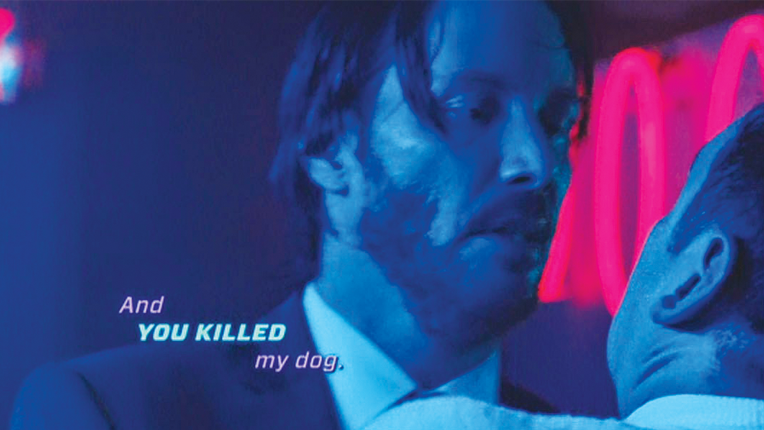In John Wick we see that some words that are said in English are written on the screen in different colors. Did they have any special meaning? Like if we place those words (e.g. the blue ones) next to each other will we get a sentence that should have a meaning or something?
-
As far as I remember, The English words are shown on screen when people are conversing in crowded areas like pubs. I think the reason for showing English words on screen because, even though characters are conversing in English in places with loud music and racket, audience wouldn't understand what characters are actually speaking in the movie.– chaitanya89Commented Mar 24, 2015 at 10:57
-
@chaitanya89 That would be quite a lame reason, though. I don't think they form a secret message either, but first and foremost they have probably been placed on screen as a stylistic device to emphasize the dialogue, rather than just to accomodate for people not acoustically understanding it.– Napoleon WilsonCommented Mar 24, 2015 at 11:01
-
@NapoleonWilson I agree that they've put words on screen "as a stylistic device to emphasize the dialogue", you're right, But they've mainly shown the words for Russian translations. Here OP was asking even for the English conversations they've put words on screen.– chaitanya89Commented Mar 24, 2015 at 12:53
-
Well, the words by themselves didn't make any sentences and didn't have any special meaning. As far as i know their colors are like disco lightning which are very disordered.– starmanCommented Mar 24, 2015 at 18:50
-
3Possible duplicate of What is the purpose of the specialized subtitles during "The Boogeyman" song?– Martin SchröderCommented Feb 27, 2017 at 22:23
1 Answer
I can't find any articles that have found hidden meaning (in terms of word re-arrangement) for John Wick's impressive subtitle typography, but I did find and article from a website called Videomaker from 2015, discussing new innovations for film subtitles by using typography techniques. The article includes what this does for John Wick.
The limitations of older subtitling tools are no longer a restraint for editors. As a result, editors can use their graphics packages to apply the rules of typography to their subtitles. It can be as simple as sizing and placing the text on screen so it doesn’t interfere with the mise-en-scene of imagery, or instead plays with it. This is a technique often used in title sequences that utilize shot footage. Along with the placement of type, the editor can change the size of their text, even varying the size of words within a phrase to place emphasis. In this a way, a viewer who is watching without the sound, or who is unfamiliar with the spoken language of the film, will know what words carry the most meaning. It’s also a way to highlight an actor’s dynamic performance. This technique was done for the subtitles of the 2004 Denzel Washington film, “Man on Fire.”
Typography wields great power, and the use of various letterforms imparts meaning upon the words they represent. A simple font choice can change the way an audience interprets what they read. Choosing the right font for any given message is not a task to be taken lightly, and it’s one that should always be considered. The 2014 Keanu Reeves film, “John Wick,” used varying typefaces to impart meaning on its subtitles and to place emphasis on certain words. It was done not only by changing the typeface used, but the color and styling of the chosen words were changed to stand out as well. The resulting type is closer to what is found in the graphic design of posters and magazine covers than what is normally experienced when reading subtitles.
The different colors, size, and font, allow for word "emphasis" and help establish personality and tone, not unlike a graphic novel.
Even that idea of "poster and magazine covers", adds an additional pulpy-pop or nightclub disco/rave element that feeds into John Wick's neo-nior style, reminding viewers of trash-glam periodicals and serving as a bridge between aesthetic and dialogue, but also ultimately adding a new kind of visual layer.

